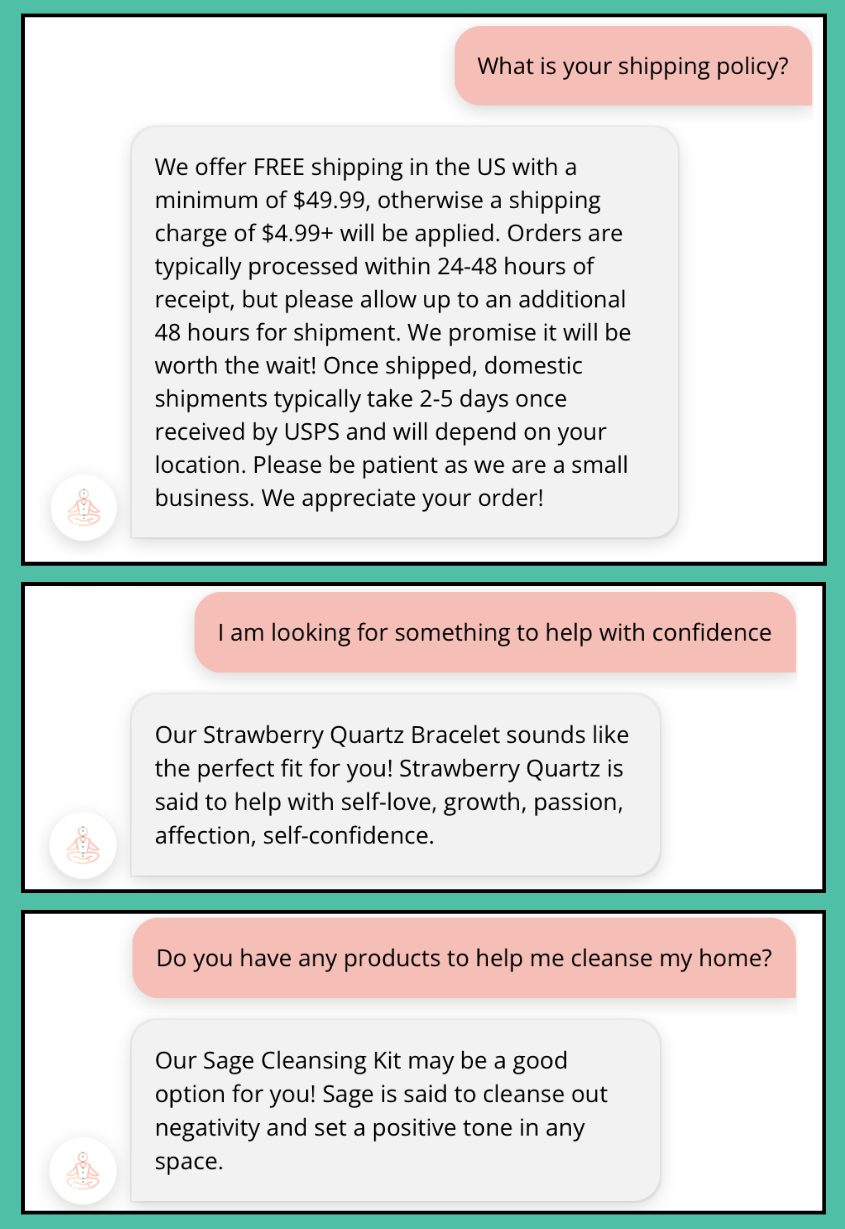AI Powered Chat Agent for E-Commerce Businesses
“The chatbot on our online shop isn’t able to help our customers with their questions. Our email inbox is flooded!”
First deployment of our new chat agent helping customers with product suggestions
Overview
Problem Statement
E-Commerce website that sells wellness and healing products looking to revamp their chatbot since it isn’t performing well
Role
Led research, design and development of the new solution
Outcome
AI powered chat agent that helps customers through their journey from page landing to purchase
Pain Points
Our Solution
Process
Step 1: Understand the Problem
My first step was to understand what kind of issues customers had that would prompt them to ask the chatbot.
I analyzed all chatbot conversations from the past year, and discovered I could categorize most questions into the following
Product Questions - When customers had questions about a specific product
Product Suggestions - When customers did not know what product they wanted, but had a problem they wanted to solve
Policy Questions - Questions on shipping, returns and other logistical clarifications
We needed a chatbot that could somehow learn about all the different products, answer questions about them, and talk to customers in a natural way.
Question 1: Can we modify the current chatbot to do this?
Answer: No.
Question 2: Is there a 3rd party solution that fits our needs?
Answer: There are 3rd party chatbot and AI chat apps, but none of them can answer questions effectively from custom data in the way we wanted
Based on the above, we decided to build a quick and minimal prototype to see if we had a viable path forward.
Step 2: Prototyping & System Design
The steps I used in the prototyping phase
Training data for the first prototype
The results from the above method were underwhelming-
Chat agent could not properly use URL’s from the training data to give customers links to certain products
The model would modify the URL, treating it as plain text
Unable to answer simple prompts from the training data
Model would respond with made up information
Not consistent in answering similar questions - responses were a hit or a miss
Step 2.1 Rethinking our solution (RAG Model)
The current solution was neither feasible nor provided results as expected. OpenAI had just released a new API for developers to use, so I looked into it. This provided us with a much better alternative to manually fine tuning GPT.
“In a 2020 paper, Meta (then known as Facebook) came up with a framework called retrieval-augmented generation to give LLMs access to information beyond their training data.
RAG allows LLMs to build on a specialized body of knowledge to answer questions in more accurate way.”
-Kim Martineau, IBM
This meant that we could feed custom data to the AI model which empowered it to put together cohesive responses to customer questions.
Just what we needed!
Step 3: Implementation
I Implemented the RAG model and put together the backend system using OpenAI, python and Google’s DialogFlow
I set up the front end of the chatbot with the help of 3rd party solutions
Deployed the AI agent to one of our E-Commerce sites to see how real customers benefit from it
Our new solution in action
Success! Our agent is now able to answer questions, and help customers pick products to address their needs!
After our success deploying the chat agent to 2 of our E-Commerce stores, I built the whole solution as a Shopify app and published it on the App Store for shop owners to use - this would give them access to a custom “Chat-GPT” on their website that could talk to customers and help them make a purchase!
Next Steps: Scaling our solution
We now had a custom AI powered chatbot that could respond to customer queries in a natural and human way- without needing a live agent to get on the line.
We needed a way to scale this solution to easily apply it to other websites and businesses.
Store owners would be able to plug our chatbot into their website, with the following features-






